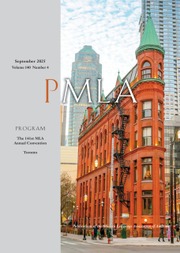No CrossRef data available.
Article contents
Marxism, Cultural Studies, and the Rise of Indigenous Studies
Published online by Cambridge University Press: 28 October 2025
Abstract
An abstract is not available for this content so a preview has been provided. Please use the Get access link above for information on how to access this content.

Information
- Type
- Theories and Methodologies
- Information
- Copyright
- © 2025 The Author(s). Published by Cambridge University Press on behalf of Modern Language Association of America
References
Works Cited
Adams, Howard. Review of Marxism and Native Americans, edited by Churchill, Ward. American Indian Culture and Research Journal, vol. 8, no. 4, 1984, pp. 58–62.Google Scholar
Andersen, Chris, and O’Brien, Jean, editors. Sources and Methods in Indigenous Studies. Routledge, 2018.Google Scholar
Brennan, Timothy. Review of Marxism and the Interpretation of Culture, edited by Nelson, Cary and Grossberg, Lawrence, and Paul Nizan: Communist Novelist, by Michael Scriven. Modern Fiction Studies, vol. 35, no. 2, summer 1989, pp. 367–70.Google Scholar
Byrd, Jodi A., and Rothberg, Michael. “Between Subalternity and Indigeneity: Critical Categories for Postcolonial Studies.” Interventions: International Journal of Postcolonial Studies, vol. 13, no. 1, 2011, pp. 1–12.CrossRefGoogle Scholar
Cook-Lynn, Elizabeth. “Who Stole Native American Studies?” Wicazo Sa Review, vol. 12, no. 1, 1997, pp. 9–28.CrossRefGoogle Scholar
Coulthard, Glen. Red Skin, White Masks: Rejecting the Colonial Politics of Recognition. U of Minnesota P, 2014.10.5749/minnesota/9780816679645.001.0001CrossRefGoogle Scholar
Dunbar-Ortiz, Roxanne A. “The Relationship between Marxism and Indigenous Struggles and Implications of the Theoretical Framework for International Indigenous Struggles.” Historical Materialism, vol. 24, no. 3, 2016, pp. 76–91.CrossRefGoogle Scholar
Estes, Nick. Our History Is the Future: Standing Rock versus the Dakota Access Pipeline, and the Long Tradition of Indigenous Resistance. Verso, 2019.Google Scholar
Hall, Stuart. “The Toad in the Garden: Thatcherism among the Theorists.” Marxism and the Interpretation of Culture, edited by Nelson, Cary and Grossberg, Lawrence, U of Illinois P, 1988, pp. 35–57.Google Scholar
Innes, Robert Alexander. “Introduction: Native Studies and Native Cultural Preservation, Revitalization, and Persistence.” American Indian Culture and Research Journal, vol. 34, no. 2, 2010, pp. 1–9.CrossRefGoogle Scholar
Kauanui, J. K. “False Dilemmas and Settler Colonial Studies: Response to Lorenzo Veracini: ‘Is Settler Colonial Studies Even Useful?’” Postcolonial Studies, vol. 24, no. 2, 2021, pp. 290–96.CrossRefGoogle Scholar
Kolopenuk, Jessica. “The Pretendian Problem.” Canadian Journal of Political Science, vol. 56, no. 2, 2023, pp. 468–73.CrossRefGoogle Scholar
Maracle, Lee. I Am Woman: A Native Perspective on Sociology and Feminism. 2nd, rev. ed., Press Gang Publishers, 1996.Google Scholar
Nichols, Robert. Theft Is Property! Dispossession and Critical Theory. Duke UP, 2020.10.1515/9781478007500CrossRefGoogle Scholar
The Red Nation. The Red Deal: Indigenous Action to Save Our Earth. Common Notions, 2021.Google Scholar
Simpson, Leanne B. As We Have Always Done: Indigenous Freedom through Radical Resistance. U of Minnesota P, 2017.Google Scholar
Truth and Reconciliation Commission of Canada: Calls to Action. Truth and Reconciliation Commission of Canada, 2015.Google Scholar
Warrior, Robert. “The Subaltern Can Dance, and So Sometimes Can the Intellectual.” Interventions: International Journal of Postcolonial Studies, vol. 13, no. 1, 2011, pp. 85–94.10.1080/1369801X.2011.545579CrossRefGoogle Scholar
Yazzie, Melanie K. “Traumatic Monologues: On the Therapeutic Turn in Indigenous Politics.” The Baffler, 6 Sept. 2021, thebaffler.com/outbursts/traumatic-monologues-yazzie.Google Scholar

